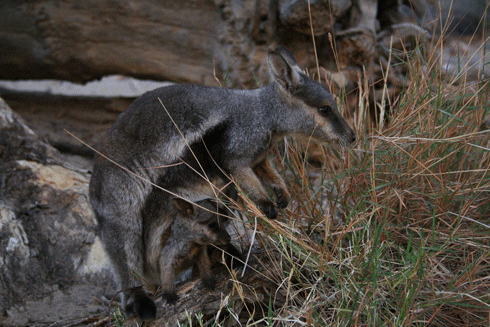
|
Published: 21 June 2013
Experts re-assess Kimberley wallaby numbers
The World Wildlife Fund and Indigenous rangers have commenced a survey of three Kimberley rock wallaby species, with preliminary findings suggesting a local decline in some populations.
World Wildlife Fund ecologist Darren Grover says the animals’ habitats have not been surveyed for up to 10 years, and there are concerns about declining numbers in the wild due to changing fire regimes and feral animal predation.
‘There’s the black footed or black flanked rock wallaby (Petrogale lateralis) which is in the West Kimberley, inland from Broome in some of that rocky country, and up in the North Kimberley are the Nabarlek (Petrogale concinna) and the Monjon (Petrogale burbidgei),’ Mr Grover says.
The researchers use motion-sensor cameras and walk transect lines, making scat counts and noting any tracks and visual sighting of the wallabies.
A study of the black-footed wallaby has already begun.
‘We did get some fleeting glimpses of them, we got some footage off the cameras as well but it certainly appears that if they are there they’re not in very high numbers,’ he says.
‘Much of the suitable habitat has been compromised by fires that are too regular and too intense which means the areas of habitat available to the rock wallaby is contracting.
‘Also feral competitors: donkeys are quite common, [and] other feral animals that are likely to feed on the same sorts of plants as the rock wallaby.
‘Thankfully [there was] not a lot in the way of feral predators.
‘So the thinking is, and it’s still only early days, that the habitat is being degraded and this is leading to a reduced population size for these wallabies.’
Numbers appear to have declined in the areas studied but further surveys are planned this year.
Mr Grover says that while populations of Australia’s larger macropod species were thriving and may actually have increased since European colonisation, smaller species were less adaptive.
‘There’s a number of species that have become extinct and other species [out] there whose range has drastically reduced,’ he said.
‘The other rock wallabies in the North Kimberley are in very inaccessible areas, pretty hard to get to, difficult to know exactly how many of them there will be and our work throughout this year will be focusing on those species and hopefully we’ll get a better picture.
‘You’d like to think that inaccessibility and that remoteness will mean that the populations are still strong but until we get in there and have a good look it’s difficult to tell.’
Source: ScienceNetwork WA




